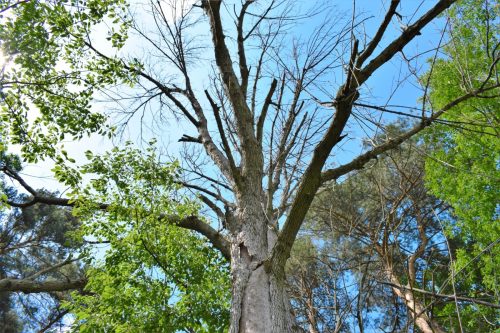If You See This Bug on Your Trees, Call Local Officials Immediately, USDA Warns

With summer right around the corner, we’re eagerly awaiting the chance to spend more time outside after being cooped up all winter. Temperatures are rising, flowers are in bloom, and foliage is lush and vibrant. But if you enjoy sitting beneath a shady tree in your yard, you’ll want to keep an eye out for signs that it’s infested with an invasive and destructive bug. Read on to find out what insect you should report to local officials immediately.
READ THIS NEXT: If You Have This Tree in Your Yard, Cut It Down Now, Officials Warn.
There are a number of invasive pests that can harm your plants and trees.

In addition to tree-munching pests like termites and aphids, there are several invasive species that pose a threat to native wildlife in the U.S. These species disrupt our ecosystems, as plants and trees generally do not have the necessary defense mechanisms to protect themselves from foreign threats.
Garlic mustard is one such invasive species, sprouting earlier than other plants around it and literally weeding out surrounding wildlife by commandeering resources. American hardwood trees are also prey for the invasive Asian Longhorned Beetle, defined by the U.S. Department of Agriculture (USDA) as the greatest threat to this particular group of trees. But there is another bug that preys on a different tree variety—native ash trees.
READ THIS NEXT: If You See a Tree That Looks Like This, Call Officials Immediately.
Keep an eye out for this bright beetle on your trees.

If you have ash trees in your yard, they could be the perfect target for the emerald ash borer (sometimes referred to as EAB), officials warn. This beetle is a “destructive wood-boring” invasive species, according to the USDA Animal and Plant Health Inspection Service (APHIS), responsible for killing millions of ash trees in North America since it was first detected in Michigan in 2002. To date, the insect has been detected in 35 states and Washington, D.C.
The emerald ash borer originated in Asia, having been accidentally transported to the U.S. on trade routes, Charles van Rees, PhD, conservation scientist, naturalist, and founder of the Gulo in Nature blog, said. And while ash tree varieties in Asia have evolved to protect themselves from the harmful effects of the beetle, trees in North America cannot say the same.
“Unfortunately, our native ash species have none of these protections, which leads them vulnerable to being wiped out,” van Rees said. “This is leading to millions of dollars of damages to private property, forestry resources, and more.”
Unfortunately, the beetle is most dangerous before you can see it.

You can recognize the adult emerald ash borer thanks to its coloring, which van Rees described as “a beautiful sparkly emerald green.” The beetle’s cylindrical body is about one-third of an inch long (smaller than a penny), accompanied by short antennae. It is sometimes mistaken for the six-spotted green tiger beetle, which is native to the U.S.—the key difference is the emerald ash borer’s reddish abdomen, van Rees explained.
This bright green bug may sound easy to spot, but unfortunately, fully-grown emerald ash borers are not the main source of the problem. According to van Rees, the larvae pose the real threat by carving tunnels in the bark of ash trees to feed on vascular tissues.
“This interferes with the necessary movement of water and sap up and down the tree’s trunk,” van Rees said. “You can think of this like internal bleeding, or a loss of blood pressure. Unable to run its body properly by moving water and sugars where they need to go, the ash tree succumbs quickly, especially when a large number of larvae have attached to it.”
The larvae often form S-shaped galleries when feeding on the inner layers, according to the USDA. When they reach maturity, the adult beetles emerge from trees through D-shaped exit holes throughout May and early June.
RELATED: For more up-to-date information, sign up for our daily newsletter.
Your ash tree could give you signs that it’s infested.

According to the USDA, you may not immediately recognize an infestation, as symptoms can take three years to appear.
When signs of an infestation do show up, your tree might look sickly and have wilted or yellow foliage, van Rees said. In addition to the D-shaped exit holes, you may see dying branches on the top of your ash tree, excessive shoots growing from the trunk, and vertical splits in the bark, the USDA warned.
“If a tree has loosening or falling bark, leading to bare spots, that’s also a useful indicator,” van Rees added. “Unusual amounts of woodpecker activity can also indicate that these hungry birds have found the larvae inside.”
If you see this beetle, report it to the proper authorities.

The USDA has formed the APHIS EAB Program, which uses the beetle’s natural enemies, tiny stingless wasps, as a way to control the EAB. To prevent and manages infestations for your individual ash trees, the Wisconsin Horticulture Division of Extension suggests using insecticide treatments but advises that you consider the value of your ash tree before making any formal decisions.
If you see signs of the emerald ash borer or the physical beetle on your trees, the USDA asks that you report it to local officials in order to help stop the spread.
Van Rees recommends reaching out to your local college agricultural extension agency, as well as contacting APHIS using an online form or by phone at 1-866-322-4512. You can also use apps like EddMapS to report on the go.
READ THIS NEXT: If You See This Flower in Your Yard, Call Local Officials Immediately.